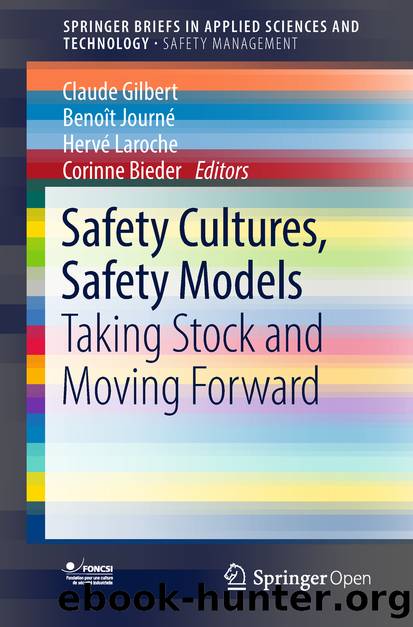Safety Cultures, Safety Models by Unknown

Author:Unknown
Language: eng
Format: epub
ISBN: 9783319951294
Publisher: Springer International Publishing
2 The Visual Side of Safety
In the past few decades, history, sociology, anthropology and the philosophy of science and technology have engaged in a strong and sustained interest for the world of visualisations (Coopmans, Vertesi, Lynch, & Woolgar, 2014). Latour has been one of the early promoters of this interest for the materialisation of scientific practices (Latour, 1986; Latour & Woolgar, 1979). In “Thinking with eyes and hands”, Latour convincingly argued for paying greater attention to the diversity of what he described as “inscriptions”, these textual, graphic or computerised supports and traces of all sorts that scientists manipulate daily to describe, to approach, to depict, to comprehend, to conceptualise, to explain, to anticipate, to predict phenomena. They provide the concrete visual support through which one can build or construct networks of inscriptions within which an understanding of phenomena is possible, and a world enacted.
Of course, beyond the practice of science, in our current image-saturated culture, including the issue of big data, people rely on a kind of visual literacy which consists of constructing meaning from everything we see. The notion of visual literacy—derived from the notion of literacy initially developed to investigate the relation between thinking and writing (Olson, 1998)—is an ability developed from early age to adulthood in order to evolve and to cope in an environment in which a very good part of our information is received through our eyes.
Translated into the daily practices of the process industry, one can indeed observe that there is a world of images made of texts, signs, diagrams (including PID: process instruments diagrams), alarms, thresholds, schemas, tables, pictograms, posters, procedures, schedules, Gantt charts, indicators, maps, logs, forms, etc., supporting and guiding actions (Le Coze, 2015; Le Coze, forthcoming). These pictures are based on graphical features such as lines, shapes, colours, spaces and textures but also balance, variety, movement, proportion, etc. Here are some examples and selections of pictures, drawings and graphics which structure the environment of safety management in high risk systems. I indicate artefacts which primarily concern the activity of different actors of safety critical systems.
Download
This site does not store any files on its server. We only index and link to content provided by other sites. Please contact the content providers to delete copyright contents if any and email us, we'll remove relevant links or contents immediately.
Tools of Titans by Timothy Ferriss(6934)
Change Your Questions, Change Your Life by Marilee Adams(6635)
Deep Work by Cal Newport(5451)
Man-made Catastrophes and Risk Information Concealment by Dmitry Chernov & Didier Sornette(4728)
Big Magic: Creative Living Beyond Fear by Elizabeth Gilbert(4716)
The Slight Edge by Jeff Olson(4715)
The Motivation Myth by Jeff Haden(4521)
Digital Minimalism by Cal Newport;(4509)
Stone's Rules by Roger Stone(4412)
Ego Is the Enemy by Ryan Holiday(3982)
The Laws of Human Nature by Robert Greene(3935)
Tuesdays with Morrie by Mitch Albom(3827)
Rising Strong by Brene Brown(3777)
Eat That Frog! by Brian Tracy(3505)
Skin in the Game by Nassim Nicholas Taleb(3455)
The Money Culture by Michael Lewis(3276)
Skin in the Game: Hidden Asymmetries in Daily Life by Nassim Nicholas Taleb(3259)
Believe It to Achieve It by Brian Tracy & Christina Stein(3199)
Bullshit Jobs by David Graeber(3171)
